Text
How to Handle Having TOO MUCH To Do
So let’s say you’re in the same boat I am (this is a running theme, have you noticed?) and you’ve just got, like, SO MUCH STUFF that HAS to get done YESTERDAY or you will DIE (or fail/get fired/mope). Everything needs to be done yesterday, you’re sick, and for whatever reason you are focusing on the least important stuff first. What to do!
Take a deep breath, because this is a boot camp in prioritization.
Make a 3 by 4 grid. Make it pretty big. The line above your top row goes like this: Due YESTERDAY - due TOMORROW - due LATER. Along the side, write: Takes 5 min - Takes 30 min - Takes hours - Takes DAYS.
Divide ALL your tasks into one of these squares, based on how much work you still have to do. A thank you note for a present you received two weeks ago? That takes 5 minutes and was due YESTERDAY. Put it in that square. A five page paper that’s due tomorrow? That takes an hour/hours, place it appropriately. Tomorrow’s speech you just need to rehearse? Half an hour, due TOMORROW. Do the same for ALL of your tasks
Your priority goes like this:
5 minutes due YESTERDAY
5 minutes due TOMORROW
Half-hour due YESTERDAY
Half-hour due TOMORROW
Hours due YESTERDAY
Hours due TOMORROW
5 minutes due LATER
Half-hour due LATER
Hours due LATER
DAYS due YESTERDAY
DAYS due TOMORROW
DAYS due LATER
At this point you just go down the list in each section. If something feels especially urgent, for whatever reason - a certain professor is hounding you, you’re especially worried about that speech, whatever - you can bump that up to the top of the entire list. However, going through the list like this is what I find most efficient.
Some people do like to save the 5 minute tasks for kind of a break between longer-running tasks. If that’s what you want to try, go for it! You’re the one studying here.
So that’s how to prioritize. Now, how to actually do shit? That’s where the 20/10 method comes in. It’s simple: do stuff like a stuff-doing FIEND for 20 minutes, then take a ten minute break and do whatever you want. Repeat ad infinitum. It’s how I’ve gotten through my to do list, concussed and everything.
You’ve got this. Get a drink and start - we can do our stuff together!
94K notes
·
View notes
Photo
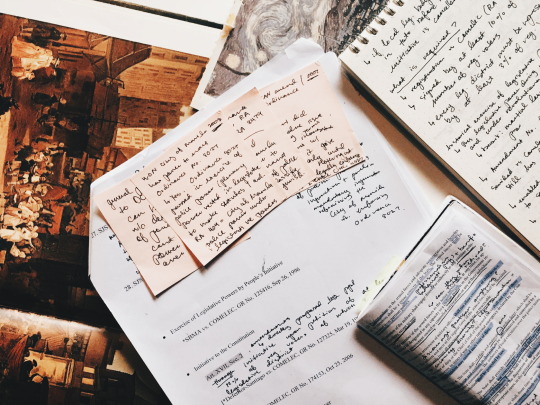
a rainy day, some constitution notes, and a lot of sleepiness.
6K notes
·
View notes
Text
i only type in lowercase because i hate capitalism
216K notes
·
View notes
Text
you’ve heard of ‘dark academia’, now its time for ‘light’ academia… wearing light linen sundresses in foreign countries, eating picnics and pastries in the afternoon sun while reading poetry and laughing with your friends, the burning passion and excitement when you finally make a breakthrough in your research, falling asleep in your lovers arms sunkissed and happy… everything is beautiful and hopeful and no one dies
19K notes
·
View notes
Text
why am i not currently in the italian countryside with a fruit plate & wearing a light linen dress? unacceptable
207K notes
·
View notes
Text
College Note-Taking System
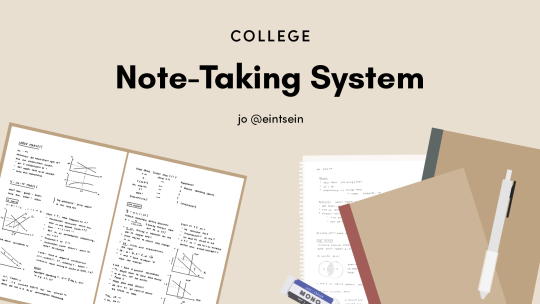
Having cohesive and effective notes is one of the key skills I think one should have, especially in an academic setting. When you’re receiving a ton of information each day, you want to be able to keep track of that and remember what you’ve learned. I’m constantly trying out ways to make my note-taking more effective and tailored to my needs. Here’s what my note-taking system looks like so far.
Quick note: click on the images for better quality!
Class Notes
Taking notes in class is an invaluable way to keep track of the new knowledge you’ve gained. However, depending on the mode in which the lecture material is conveyed, I take my notes differently. Here’s a summary of how I take my notes for each type of lecture, as well as some examples from the classes I’m taking now.
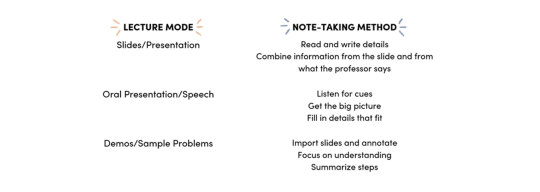
Slides (e.g. Macroeconomics)
Macroeconomics is a class in which you should be able to intuitively understand a lot of concepts but also remember a lot of things. Because of this, I’ve tailored my note-taking method and habits to achieve that goal.
I write my notes by hand because handwriting is more effective in committing things to memory.
As for what I actually do - and this is what I’ve done for other classes in which the professor/lecturer uses slides:
Read/skim over the slide.
Read each bullet point as the professor goes through them.
Copy it down if it’s straightforward or write it down in a structure and diction that I understand better (not necessarily in my own words - sometimes it’s just restructuring, e.g. splitting things up or joining different bullet points together).
Take note of any other important details the professor says about any particular point unless I think it’s intuitive or common sense.
Here’s an example from a Macroeconomics lecture.

Oral Presentation (e.g. Anthropology)
During classes in which the professor just speaks and doesn’t use much visual material, I listen before I write instead of attempting to write down every single detail mentioned.
Also, I type up my notes instead of handwriting them since the exams are all open-book so I don’t really have to commit things to memory.
Here’s what I do:
Listen for a cue that tells you what this particular part of the lecture will be about (and write it as a heading).
Write down main ideas and their supporting facts/details. If the facts/details come before the main ideas, then I’d usually draw an arrow.
Write down ideas and details from readings in their own section/subsection.
Sometimes, my professor also shows short clips in class, in which case I’d write down the message that I think the clip was meant to convey, as well as things that the professor points out that I didn’t think of on my own.
I’d also look up concepts/ideas/people/events (in real time) that are important to my understanding of the lecture material.
Here’s an example of a Google Docs document from an Anthropology lecture.

Demonstrations and Sample Problems (e.g. Computer Science)
Classes in which the lecture is mainly going through demos and problems are kind of tricky, because you want to know and understand what the professor is doing, but you also don’t want to be writing down every single step that’s being executed. Here’s what I’ve found to be the most effective so far:
If there are any, I import the slides/handout onto OneNote and annotate directly on the slide. If not, I just write down things like definitions, important concepts, and syntax-related things.
I focus on understanding what the professor’s doing with the demo or problem.
I then summarize the steps they took and
Write down comments and points they brought up, e.g. common errors, desirable habits/practices.
Also, these kinds of classes are usually classes in which you’d learn better when you actually do problems yourself, so I definitely learn more when I do assignments and labs than when I’m in class.
Here’s an example from a Web Programming lecture.
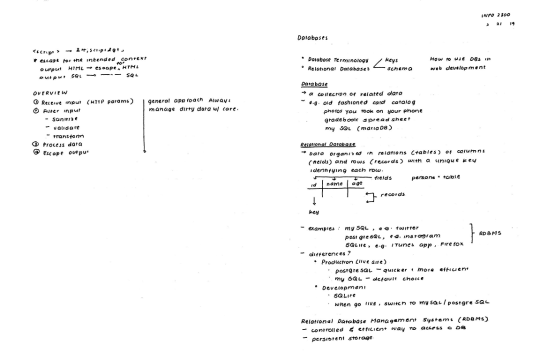
Here’s one from an Object Oriented Programming and Data Structures class. I often draw things to help me visualize the general points.
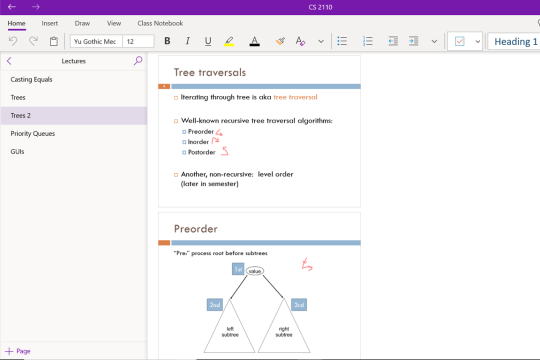
Rewritten Notes
My rewritten notes have definitely changed a lot since high school. Since most of my classes don’t require a lot of memorization, I organize my notes in such a way that they’d be easy to index or find information from. Here are some of the ways I do that:
Establishing a Visual Hierarchy
Having a well-defined hierarchy helps me flow through my notes really well as i read them. It helps me organize information like a mind map without actually making a mind map - I know the big topics and their subtopics and sub-subtopics and details … basically it’s easier to see how these ideas fit together.
But why don’t I just make mind-maps? See, the thing is, a lot of my notes require sequential or linear thinking, e.g. in macroeconomics it might be the sequence of events following a change in the economy, or in computer science it might be a general algorithm for solving a certain type of problem, or it might be proving or deriving a certain equation. These sorts of things just generally don’t work well with mind maps. Instead, establishing a visual hierarchy in my notes helps me organize different ideas while retaining the linear nature of the information.
Here’s what the hierarchy looks like.
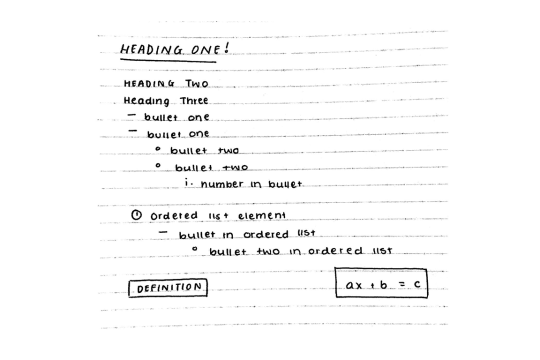
Here is an example from my Web Programming class, which is a purely project-based class, so no prelims or exams. As you can see, I draw rectangles around important terminology so that I can easily find them while I’m working on a project. I also include examples from in-class activities as well as notes on syntax so I have an idea of how to implement certain things. These examples and notes are further grouped by terminology/concept.

Structuring Them for Easier Flow
My syllabi for my college courses are nowhere near as detailed as the syllabi for my high school courses - those of you who take/have taken Cambridge exams would know. In college, my syllabi are only lists of topics and not what you’re expected to know for each topic. Because of this, I have to find a way to arrange information so that I can achieve the most comprehensive and cohesive understanding of that topic, i.e. so that the flow of my notes is similar to the flow of my thinking.
For example, in my economics notebook, I like to have the details first (e.g. the separate markets: the goods market, the assets market, and the labor market) and then the big picture later (IS-LM-FE). Some people prefer the other way around - seeing the big picture and then going into the details - which I can understand and have done myself for certain topics.
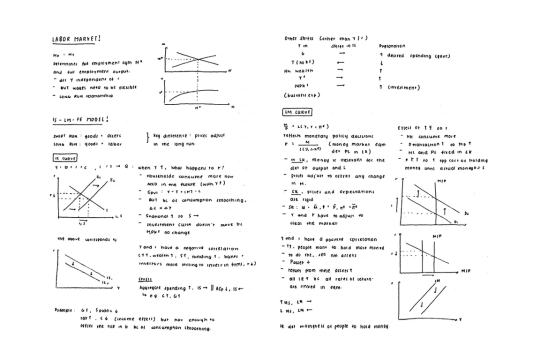
Making Use of Proximity and Spacing
I very much dislike notes without good use of spacing and grouping things together. Keeping related ideas in visual proximity helps your brain (or at least mine) organize this information. It’s also a lot easier to find things and visualize your notes when they’re not just a huge chunk of text.

One thing I should probably mention is that I don’t use colored pens anymore because it just takes a lot of time to switch pens and think of a color palette. I also don’t have much use for it. In the past, I used color to help me memorize and group things in different categories, but now, I’ve found that there aren’t a whole lot of categories I need to keep track of, and when I do, I can do so with just one pen but changing the style of the text.
And that’s what my note-taking system currently looks like. It’s working well so far, but I still think there are other things I could try out that might be a better fit.
So yeah, hope this was helpful, and as always, feel free to drop an ask if you have any questions, or even if you have any suggestions or would like to share your note-taking system. Have an awesome week!
10K notes
·
View notes
Text
The 5 Best Revisions Methods I Want to Start Using
Hi, guys! Whilst planning my next few months to do well on my final exams, I started researching and found a few great study techniques that are a bit underrated. Thus, I compiled a post with information about each one and all the materials you need to put them to use. These are most useful if you’ve already studied the material and are now starting to revise.
A. Feynman Technique
This method was coined by Nobel Prize winner Richard Feynman. This system works by writing down everything you remember about the topic you’re currently revising in a blank piece of paper. When you get stuck, go back to your study materials. The gaps in your knowledge should be blatant after you finish. Review and simplify. Keep repeating until you know for certain that there’s nothing left out and you’ve successfully learned the topic. :-)
For this method you will need:
Blank piece of paper
Pen/Pencil
B. Spaced Repetition
This method has been gaining traction for the past few years but it still doesn’t get the recognition it should. It’s fairly simple. It consists of time intervals between study sessions, which allows you store information better in your long-term memory. While there aren’t set times for when to do your next revision session, I’d recommend the one by Piotr Wozniak:
First repetition: 1 day
Second repetition: 7 days
Third repetition: 16 days
Fourth repetition: 35 days
This method can be used both through an analog system and a digital one.
One of the simplest techniques to implement spaced repetition while using paper flashcards is the Leitner system. First, you decide how many boxes you need for your system. Each of your boxes represents a different study time interval:

Every flashcard starts out in Box 1. When you get a flashcard right, it passes to the next box. If you get a card wrong, it goes back to Box 1 – even if it was on Box 4. This makes sure you are constantly reviewing the materials. Remember to devise a calendar with the dates and boxes you need to revise each day.
For this method you will need:
Boxes or simply different colored rubbers to differentiate the piles
Flashcards
Pen/Pencil
If however, you prefer a digital method, Anki is the best option for you. It is available online, on both Windows & Mac and there’s also an incredible practical app. It uses the spaced repetition method while taking the trouble of having to hand write hundreds of flashcards and remembering when to study each one.
Simply create an account, then a deck in which you’ll add your flashcards. The app and website allow you to add images and/or sounds to the flashcards. Customize them all you want. Once you’ve finished, save them and check the app every day to revise the flashcards of the day.
For this method you will need:
Anki app (iOS, Android) and/or website
C. Past Papers
I’ve been guilty in the past for not using this method. I got so caught up in my perfectionism that I didn’t even want to try. I learned, though, that getting things wrong is not a sign of failure and that persisting until you get it right is the real strength (and discipline) you ought to have. Do not let your procrastination and/or perfectionism prevent you from learning your weaknesses on a topic and not reach the grade you were hoping for.
Time yourself while taking the test and then correct your answers with a different colored pencil/pen so you can differentiate between correct and wrong answers.
For this method you will need:
Past papers
Pen/Pencil
D. Teach someone
This method is really helpful if you have oral assessments and/or your professor uses the Socratic method in class. You can practice your speech and knowledge all at the same time. Find someone who’s willing to listen to you talk about the topic you’re studying. Even if no one’s willing, you can still explain the matter to an object in the house. Don’t get embarrassed by this! While speaking, you’re organising your thoughts and only when explaining to someone else can you really assess your knowledge.
For this method you will need:
Your voice
Someone/Something who loves you very much
E. Proper sleep & exercise
Yes, I know, these aren’t revisions methods. But as helpful as the previous systems were, they won’t work if you aren’t sane in body and spirit. It’s incredibly important that you rest. Teenagers (13 to 17 years old) ought to sleep from 8 to 10 hours every day, while young adults (18 to 25) only need 7 to 9. You should also get fresh air and exercise. This helps with mental alertness, concentration, an efficient memory and a positive mood. Stay hydrated throughout the day. & please, don’t skip meals!
For this method you will need:
Proper sleep (x, x, x, x, x)
Exercise (x, x, x)
Healthy diet (x, x, x, x)
12K notes
·
View notes
Photo





Loving Vincent (2017) Directed by Dorota Kobiela and Hugh Welchman
12K notes
·
View notes
Photo

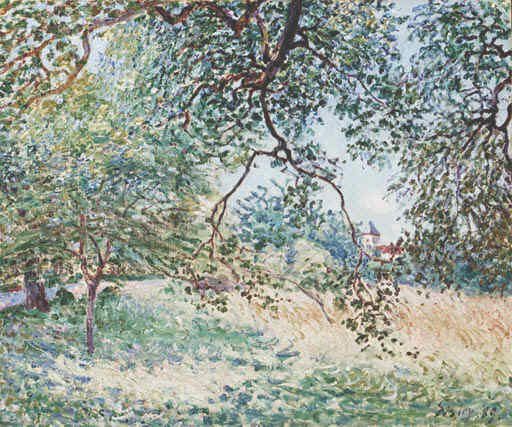
Art Comparison: Spring
Vincent van Gogh - Banks of the Seine in the Spring, 1887
Alfred Sisley - Edge of Forest in Springtime, 1890
1K notes
·
View notes
Photo

Designer Omer Arbel’s Eclectic Home in Vancouver // Dwe
2K notes
·
View notes
Text
speak it into existence: tomorrow will be better, everything will be okay in the end
34K notes
·
View notes
Photo

Two things I’m working on today: I am the co-editor of a special edition of the Goldsmiths literature journal (GLITS), so I’m currently checking over peer review sheets and manuscript feedback from our board of editors.
I am also writing questions for an event I’ve been putting together as part of Alternative Careers Week at Goldsmiths, which is a conversation about the challenges facing prospective academics between myself, Dhanveer Brar, Beth Guilding, Jake Hall, Akanksha Mehta and Roberto Mozzachiodi.
You can find the details of the event here: Is a Career in Academia Worth it?
9K notes
·
View notes
Photo


18.03.2018 // Essays and tea and avoiding the snow outside.
7K notes
·
View notes
Photo





Loving Vincent (2017) Directed by Dorota Kobiela and Hugh Welchman
12K notes
·
View notes


